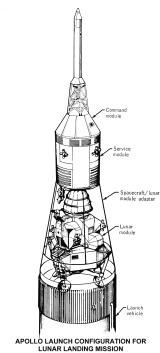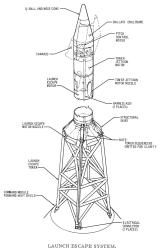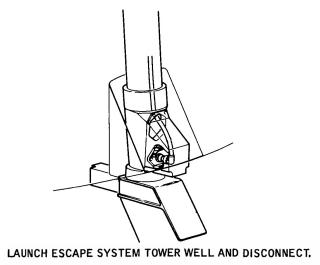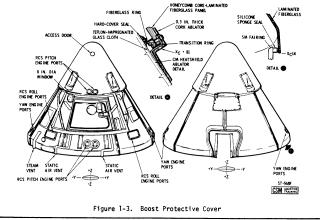Launch Escape Subsystem
Launch Escape Subsystem(LES)
- Height : 33ft (10.0584m)
- Diameter (body) : 26.4in (67cm)
- Weight : 8000lb (3.632ton)
- Manufacturer : Lockheed Propulsion Co. & Thiokol Chemical Corp.

Structure
The LES tower has 3 solid rocket motors stored in the body. The first is the Launch Escape Motor, which has four nozzles in the bottom part of the body. It carries the CM away from the booster during an emergency, providing about 147,000 pounds of thrust in 3.2 seconds of burning. The second solid rocket motor is the Tower Jettison Motor, which has two nozzles in the center of the body. It is used to jettison the LES and BPC from the CM, either after a normal launch or after an emergency escape. It provides about 31,500 pounds of thrust in about one second of burning. The third solid rocket motor is the Pitch Control Motor, stored in the top of the body. It is used for changing the flight course during an emergency, after it has lifted the CM from the booster. It provides about 2,400 pounds of thrust in about a half second of burning.

A control device called the Q-ball is installed at the top of LES. There are 8 static ports on it for sensing the vehicle's flight angle by detecting changes in the atmospheric pressure. This provides flight information for the guidance computer controlling the flight course. Two canards are folded under the Q-ball. Each canard is installed just under nose cone with two hinges. Movements are controlled by an actuator, driven by compressed gas.
The LES tower legs are made of titanium tubes of 2-1/2 and 3-1/2-inch diameter, connected to CM with explosive bolts. For heat-resistance, the legs are covered with Buna N rubber.

Emergency Detection
The launch escape system goes into operation when thrust from two or more engines of the S-IC are lost, or the flight angle (pitch, yaw, roll) deviates beyond set parameters.
When a emergency is detected after the launch within 100 seconds, the LES works automatically, drawing the CM from the Saturn rocket. Or, until the LES has been jettisoned, the astronauts can start it manually. When there is no emergency, the LES is jettisoned with the BPC at 295,000 feet (89,900m), or about 30 seconds after second stage (S-II) ignition. (with the Saturn IB, 275,000 feet or about 20 seconds after second stage (S-IV) ignition.)

Escape
When a mission is aborted, the engines of Saturn booster are stopped first. However, in the case of an emergency within 30 seconds from launch, the booster engines are kept burning until 30 seconds have elapsed since launch. (with the Saturn IB, kept burning 40 seconds) Next, the Launch Escape Motor in the bottom part of LES is ignited, and the LES, BPC, and CM are jettisoned from SM. By igniting the Pitch Control Motor on top of the LES, the CM leaves the flight course of booster.


When a mission is aborted after LES jettison, the CM is separated from Saturn booster with the SM. The RCS engines on the SM are used for booster separation, and the SPS engine on the SM is used to change orbit. An abort switch is initiates this, and the process is done automatically. The spacecraft then follows procedures as in a normal entry.
Boost Protective Cover(BPC)
- Height : 11ft (3.35m)
- Diameter : 13ft (3.96m)
- Weight : 700lb (318kg)




























